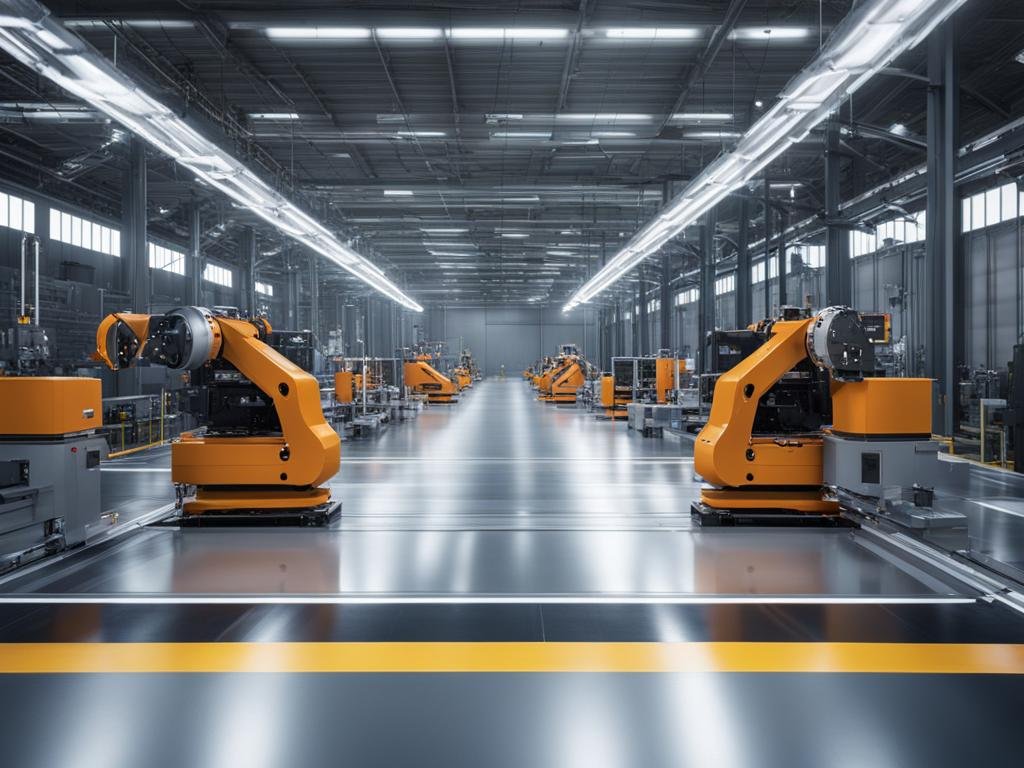Technological advances in manufacturing : The manufacturing industry is experiencing a remarkable evolution driven by technological advances. From cutting-edge manufacturing technology to modern innovations, companies are embracing evolving manufacturing technologies to optimize their operations and push the boundaries of what is possible in the sector. These latest manufacturing advancements are transforming the industry and paving the way for progress.
Key Takeaways:
- Technological advances are revolutionizing the manufacturing industry.
- Cutting-edge manufacturing technology is driving innovation and efficiency.
- Evolution in manufacturing technologies is reshaping the sector.
- Modern innovations in manufacturing are optimizing operations.
- Companies are embracing the latest manufacturing advancements to unlock progress.
The Importance of Business Model Innovation for Manufacturing Companies
The manufacturing industry is undergoing a significant transformation, driven by advanced manufacturing technologies. While companies focus on improving their manufacturing operations, it is equally essential to recognize the importance of business model innovation. By leveraging advanced manufacturing technologies, manufacturing companies can optimize their operating models and create new value.
Business model innovation allows manufacturing companies to differentiate themselves from competitors and adapt to changing market dynamics. It involves identifying new revenue streams, developing unique value propositions, and exploring innovative ways of delivering products and services. By optimizing their operating models, manufacturing companies can achieve greater efficiency, cost savings, and improved customer satisfaction.
Business model innovation is crucial for manufacturing companies to thrive in today’s dynamic market. By embracing advanced manufacturing technologies, companies can optimize their operating models and create new value.
Benefits of Business Model Innovation
Business model innovation brings several benefits to manufacturing companies. Firstly, it enables companies to stay competitive in the rapidly evolving market landscape. By exploring new business models, companies can identify untapped opportunities and gain a competitive edge.
Secondly, business model innovation allows manufacturing companies to adapt to changing customer needs and preferences. By understanding customer demands and leveraging advanced technologies, companies can offer unique value propositions and deliver personalized products and services.
Furthermore, business model innovation drives operational effectiveness. By optimizing operating models, manufacturing companies can streamline processes, reduce costs, and increase operational efficiency.
Strategies for Unlocking Business Model Innovation
- Embrace advanced manufacturing technologies: Advanced manufacturing technologies such as automation, robotics, and artificial intelligence are key enablers of business model innovation. By leveraging these technologies, companies can reimagine their operations and develop new business models.
- Collaborate with partners and stakeholders: Collaboration is essential for business model innovation. By partnering with suppliers, customers, and other industry players, manufacturing companies can access new resources, expertise, and markets.
- Invest in research and development: Continuous research and development efforts are crucial for business model innovation. By investing in R&D, manufacturing companies can drive technological advancements, develop new products and services, and unlock new business opportunities.
- Adopt a customer-centric approach: Understanding customer needs and preferences is essential for business model innovation. By gathering customer insights and feedback, manufacturing companies can tailor their business models to deliver exceptional value and meet changing customer expectations.
Business model innovation is an essential element of success for manufacturing companies. By embracing advanced manufacturing technologies and adopting innovative strategies, manufacturing companies can optimize their operating models, create new value, and thrive in the ever-evolving industry.
Adapting to New Customer Needs and Demand Environment
The COVID-19 pandemic has had a profound impact on customer preferences and demands, creating the need for manufacturing companies to adapt to new customer needs and a rapidly changing demand environment. As customers seek frictionless purchasing experiences, personalized products, and transparent information, manufacturing companies must embrace technological advancements to meet these evolving requirements.
One of the key strategies for adapting to the new customer landscape is agile manufacturing. By adopting flexible and adaptive manufacturing processes, companies can quickly respond to changes in demand and deliver customized products that cater to individual customer preferences. This shift towards agility in manufacturing enables companies to stay competitive in an increasingly dynamic marketplace.
To effectively implement agile manufacturing, supply chain agility is crucial. Companies need to optimize their supply chain processes by leveraging real-time data, predictive analytics, and IoT technologies. These capabilities enable companies to monitor customer demand in real-time, optimize production and inventory levels, and ensure timely delivery of products. By building agile supply chains, manufacturing companies can enhance their responsiveness to customer needs and achieve higher levels of customer satisfaction.
Benefits of Agile Manufacturing and Supply Chain Agility
Adopting agile manufacturing and supply chain agility offers a range of benefits for manufacturing companies:
- Personalized Products: Agile manufacturing allows companies to produce customized products that meet individual customer preferences, enhancing customer satisfaction and loyalty.
- Flexibility in Manufacturing: Agile manufacturing processes enable quick reconfiguration of production lines to accommodate changes in demand, reducing lead times and improving operational efficiency.
- Supply Chain Resilience: Supply chain agility ensures companies can quickly respond to disruptions, such as supply chain interruptions or changes in customer demand, minimizing the impact on operations.
- Cost Optimization: By closely monitoring and optimizing inventory levels, agile manufacturing and supply chain agility help reduce costs associated with excess inventory and stockouts.
“Agile manufacturing and supply chain agility are essential for companies to meet the changing needs and preferences of customers in today’s dynamic business environment.”
Adapting to the Evolving Customer Landscape
Manufacturing companies must continuously adapt to the evolving customer landscape by investing in agile manufacturing processes and supply chain agility. By embracing technological advancements, companies can stay ahead of the competition and deliver the personalized products and frictionless purchasing experiences that customers now demand. The ability to quickly respond to changing customer needs and preferences is paramount for success in today’s market.
| Benefits of Agile Manufacturing and Supply Chain Agility |
|---|
| Personalized Products |
| Flexibility in Manufacturing |
| Supply Chain Resilience |
| Cost Optimization |
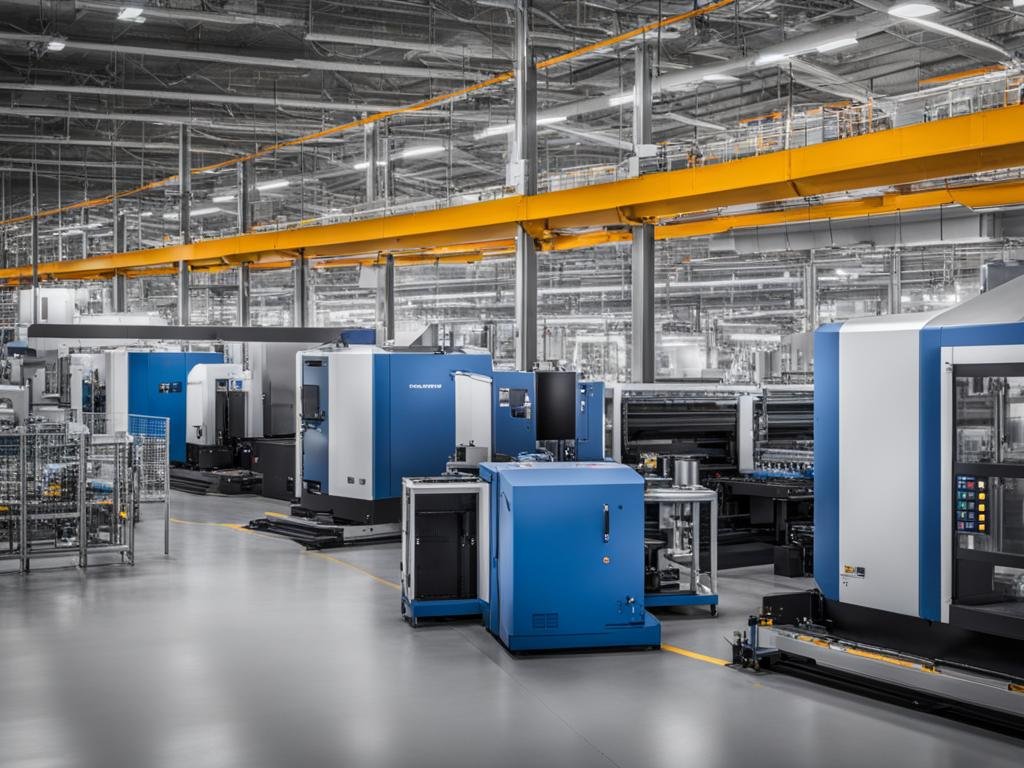
Sustainable Manufacturing: Addressing Climate Change and Embracing Circular Business Models
Sustainable manufacturing is becoming increasingly important as companies strive to reduce their environmental impact and contribute to a greener future. By implementing circular business models and leveraging advanced technologies, manufacturing companies can address climate change and work towards achieving net-zero emissions.
One key aspect of sustainable manufacturing is resource recovery and recycling. By finding new ways to reuse and recycle materials, companies can minimize waste and reduce their reliance on finite resources. For example, innovative processes and technologies can enable the recovery of valuable materials from discarded products or waste streams, which can then be used to create new products or feed back into the production cycle.
In addition to resource recovery, sustainable manufacturing also focuses on reducing CO2 emissions. Companies can achieve this by optimizing their energy usage, investing in renewable energy sources, and implementing energy-efficient technologies. For instance, the adoption of energy-efficient machinery and equipment, along with improved process controls, can significantly reduce energy consumption and emissions.
To illustrate the potential impact of sustainable manufacturing on CO2 emissions reduction, consider the following table:
| Year | CO2 Emissions (tons) |
|---|---|
| 2018 | 10,000 |
| 2019 | 9,500 |
| 2020 | 9,000 |
Implementing sustainable manufacturing practices resulted in a 10% reduction in CO2 emissions from 2018 to 2020.
By embracing sustainable manufacturing practices and circular business models, companies can not only reduce their environmental impact but also enhance their reputation and attract environmentally conscious customers. Additionally, sustainable manufacturing can lead to cost savings through improved resource efficiency and reduced waste disposal expenses. As the world becomes increasingly focused on sustainability, manufacturing companies that prioritize sustainable practices will be better positioned for long-term success.
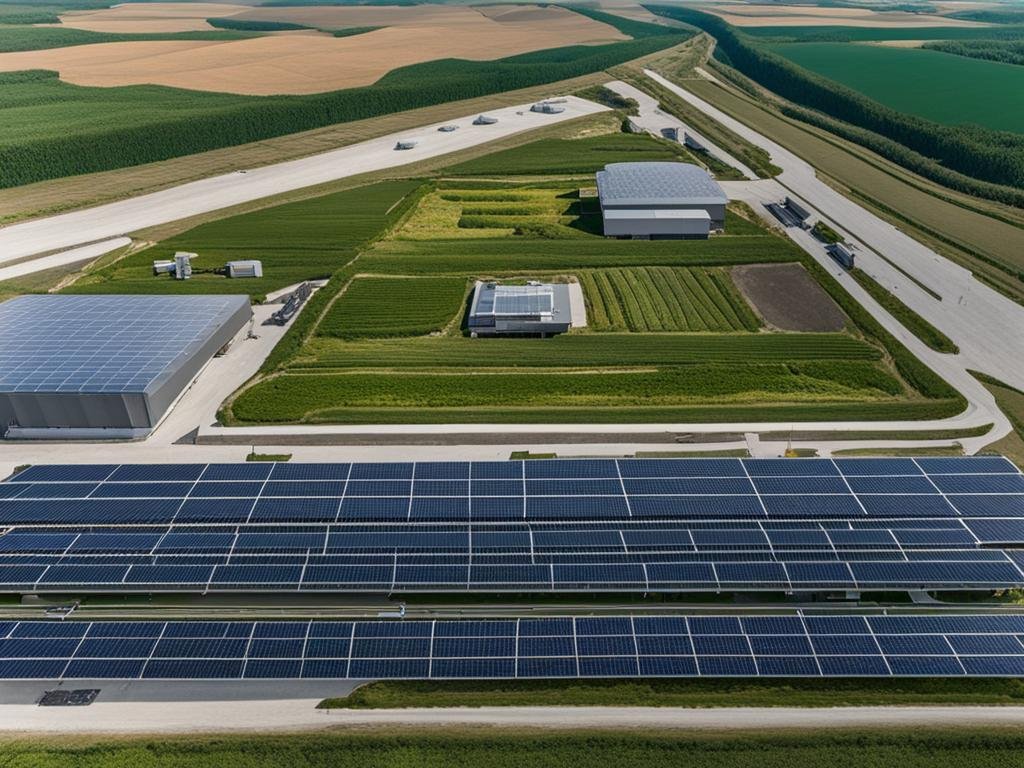
Digital Transformation: Reshaping the Manufacturing Industry
The manufacturing industry is undergoing a significant transformation with the advent of digital technologies. Digital transformation is revolutionizing traditional manufacturing processes, enabling companies to enhance their competitiveness and unlock new opportunities. Automation, robotics, artificial intelligence (AI), the Internet of Things (IoT), and Industry 4.0 are among the key pillars driving this digital revolution.
One of the primary benefits of digital transformation in manufacturing is improved efficiency. Automation and robotics technologies streamline operations, reduce errors, and increase productivity. By automating repetitive tasks, manufacturers can free up resources to focus on higher-value activities, leading to faster production cycles and improved overall efficiency.
Furthermore, the integration of AI and IoT into manufacturing processes enables real-time data analytics and predictive maintenance. This proactive approach to maintenance helps manufacturers identify potential faults or failures before they occur, minimizing downtime and maximizing productivity. Additionally, AI-powered analytics provide valuable insights for decision-making, allowing manufacturers to optimize processes, reduce waste, and improve product quality.
“Digital transformation in manufacturing is not just about adopting new technologies; it’s about fundamentally rethinking business models and operations.”
Embracing digital transformation also opens up opportunities for manufacturers to develop new business models and revenue streams. By leveraging AI and IoT technologies, companies can offer personalized products, predictive maintenance services, and remote monitoring solutions. This shift from traditional manufacturing to smart manufacturing is key to staying competitive in today’s rapidly evolving market.
Table: Digital Transformation Technologies in Manufacturing
| Technology | Applications |
|---|---|
| Automation | Streamlining operations, reducing errors, improving productivity |
| Robotics | Automating repetitive tasks, enhancing efficiency |
| Artificial Intelligence | Real-time data analytics, predictive maintenance, process optimization |
| Internet of Things | Connected devices, remote monitoring, predictive analytics |
| Industry 4.0 | Smart factories, digital supply chains, seamless connectivity |
With the continuous advancement of digital technologies, the manufacturing industry is poised for further transformation. As companies embrace digital transformation, they gain a competitive edge by optimizing operations, improving efficiency, and delivering innovative products and services. To thrive in the digital age, manufacturers must not only adopt these technologies but also reimagine their business models and operations to capitalize on the full potential of digital transformation.
Harnessing the Power of AI in Manufacturing
Artificial intelligence (AI) has emerged as a game-changer in the manufacturing industry, revolutionizing traditional processes and driving efficiency. With its ability to analyze vast amounts of data, AI enables predictive analytics, optimization, and scheduling, leading to improved operational performance and product quality. From automating repetitive tasks to optimizing production schedules, AI technology has the potential to transform manufacturing operations.
One of the key applications of AI in manufacturing is predictive maintenance. By analyzing sensor data and historical records, AI algorithms can predict equipment failures and recommend proactive maintenance actions. This not only reduces downtime and costly repairs but also extends the lifespan of machinery. Additionally, AI-powered knowledge discovery tools can uncover hidden patterns and insights in manufacturing data, enabling companies to make data-driven decisions and enhance overall productivity.
“AI technology has the potential to revolutionize the manufacturing industry by improving efficiency, optimizing processes, and empowering companies to make data-driven decisions.” – Industry Expert
Another area where AI is transforming manufacturing is product performance optimization. By leveraging AI algorithms, companies can analyze complex data sets from various sources, such as sensor readings, customer feedback, and production parameters, to optimize product designs and enhance performance. This leads to the development of higher quality products that better meet customer needs and preferences.
Applications of AI in Manufacturing
- Predictive analytics for demand forecasting
- Optimization of production schedules
- Quality control and defect detection
- Intelligent inventory management
- Efficient supply chain management
As AI continues to advance, its impact on the manufacturing industry will only grow stronger. By harnessing the power of AI, manufacturers can unlock new levels of productivity, efficiency, and innovation, positioning themselves for success in an increasingly competitive landscape.
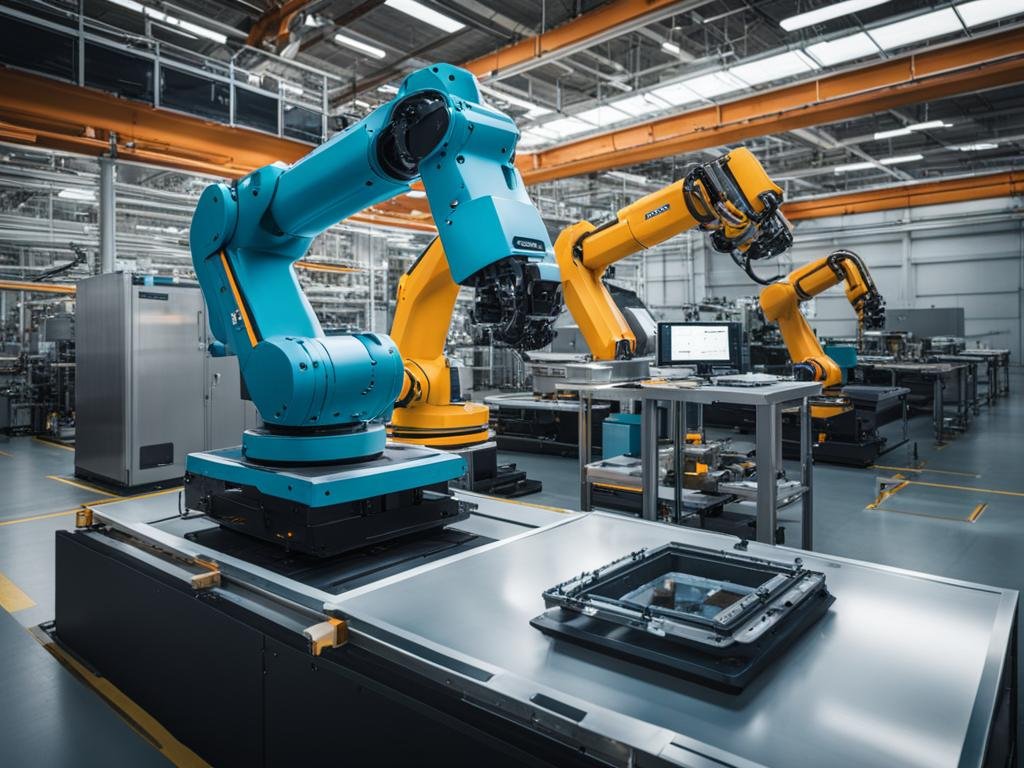
Building Agile Supply Chains with Technology
In today’s fast-paced and ever-changing business landscape, manufacturing companies need to build agile supply chains that can quickly adapt to market fluctuations and customer demands. Technology plays a crucial role in achieving this agility, allowing companies to optimize their supply chain operations and make data-driven decisions in real-time. By leveraging a combination of real-time data, predictive analytics, predictive maintenance, IoT, and cloud computing, manufacturing companies can transform their supply chains into strategic assets that drive efficiency, reduce costs, and enable faster decision-making.
One of the key advantages of technology in supply chain management is the ability to gather and analyze real-time data. This data provides valuable insights into inventory levels, production rates, customer demand, and other critical factors that influence supply chain performance. With this information at their fingertips, companies can proactively identify bottlenecks, forecast demand, and optimize their inventory levels to meet customer needs while reducing excess inventory and minimizing carrying costs.
Predictive analytics is another powerful tool that enhances supply chain optimization. By leveraging historical data and advanced algorithms, companies can forecast future demand, identify potential disruptions, and proactively implement mitigation strategies. Predictive analytics enables companies to optimize their production schedules, streamline transportation routes, and minimize the risk of stockouts or overstock situations. This not only improves customer satisfaction but also reduces costs and enhances overall supply chain performance.
Furthermore, the integration of IoT devices and cloud computing in supply chain management enables real-time monitoring and predictive maintenance. IoT devices such as sensors and RFID tags can track the movement of goods throughout the supply chain, providing real-time visibility into inventory levels, location, and condition. This enables companies to identify potential issues or delays and take corrective actions before they impact customer satisfaction or disrupt operations.
In conclusion, technology is revolutionizing supply chain operations in the manufacturing industry, enabling companies to build agile supply chains that drive efficiency, reduce costs, and enhance customer satisfaction. By leveraging real-time data, predictive analytics, predictive maintenance, IoT, and cloud computing, manufacturing companies can optimize their supply chain operations, proactively respond to market fluctuations, and make data-driven decisions. Embracing technology and building agile supply chains will be essential for manufacturing companies to navigate the challenges and opportunities of the future.
The Role of Advanced Robotics in Manufacturing
Advanced robotics plays a significant role in revolutionizing manufacturing processes. With the advancements in robotics technology, manufacturing companies are leveraging automation to enhance productivity, streamline operations, and improve quality control. Collaborative robots, also known as cobots, are at the forefront of this transformation, enabling companies to automate repetitive tasks while working alongside human workers, thereby enhancing productivity and efficiency.
One of the major advantages of advanced robotics in manufacturing is its ability to automate repetitive tasks. By offloading these tasks to robots, companies can optimize their workforce and free up valuable human resources for more complex and creative work. This automation not only improves productivity but also reduces the risk of human error, resulting in higher quality products.
Quality control is another area where advanced robotics technology plays a crucial role. Robots equipped with advanced sensors and vision systems can perform precise and accurate inspections, ensuring that products meet the desired standards. This not only reduces defects but also enhances customer satisfaction and brand reputation.
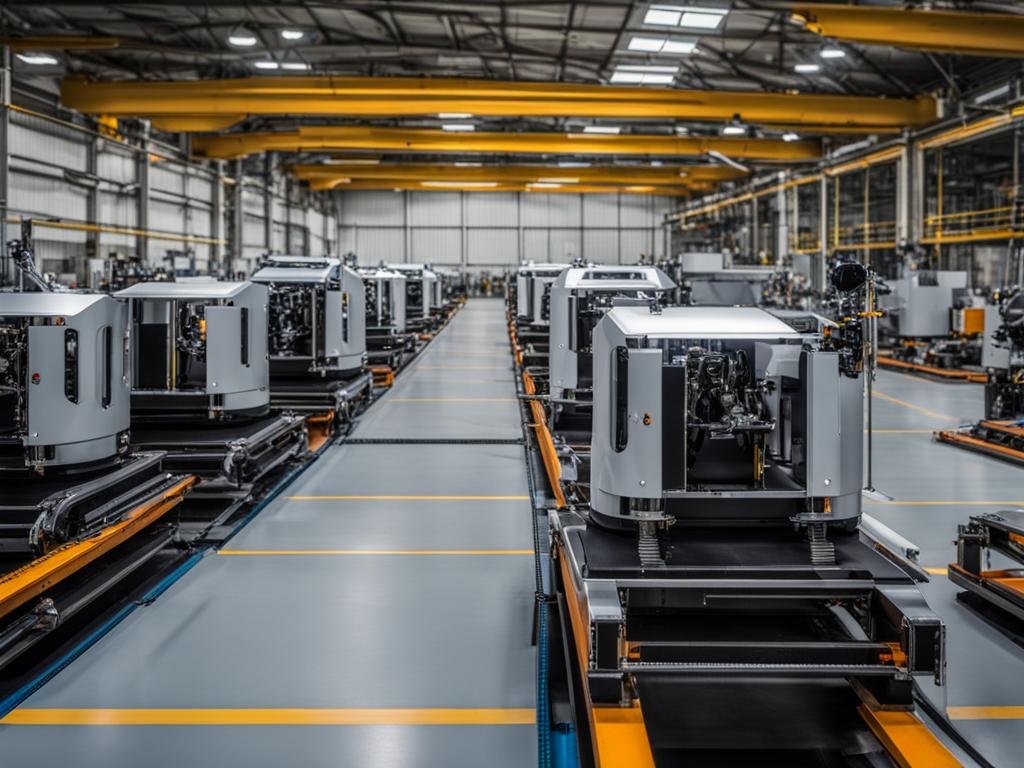
Furthermore, the use of advanced robotics allows manufacturers to enhance their overall productivity. With robots handling repetitive tasks, workers can focus on more value-added activities such as problem-solving, innovation, and process improvements. This leads to increased efficiency and a more agile manufacturing environment.
In conclusion, advanced robotics technology is transforming the manufacturing industry. By automating repetitive tasks, improving quality control, and enhancing productivity, robots are revolutionizing manufacturing processes and enabling companies to stay competitive in the ever-evolving market. As technology continues to advance, we can expect to see further innovations in robotics that will drive even greater efficiency and productivity in the manufacturing sector.
The Potential of Augmented and Virtual Reality in Manufacturing
Augmented reality (AR) and virtual reality (VR) technologies have revolutionized various industries, and manufacturing is no exception. These immersive technologies offer significant potential for enhancing training, maintenance, design, visualization, and simulations in the manufacturing process.
AR and VR can greatly improve training programs by providing realistic, interactive simulations that allow workers to practice tasks and procedures in a safe virtual environment. This enables them to gain hands-on experience and develop critical skills without the need for physical equipment or risking any accidents. Moreover, maintenance tasks can be facilitated through AR and VR, as technicians can use these technologies to access real-time visualizations and instructions, helping them to identify and resolve issues more efficiently.
Design and visualization are also areas where AR and VR have a tremendous impact. Designers can use these technologies to create 3D models and prototypes, allowing them to visualize products before they are even manufactured. This not only saves time and costs in the design process but also enables better collaboration between designers, engineers, and other stakeholders. Additionally, AR and VR can improve the visualization of complex manufacturing processes, enabling operators to better understand and optimize their workflows.
Simulations are another crucial application of AR and VR in manufacturing. By creating virtual environments, companies can simulate various scenarios and analyze the impact of different factors on production. This helps in making informed decisions, optimizing processes, and reducing risks. Moreover, simulations can be used to test new equipment, layout changes, or production line modifications before implementing them in the real world, ensuring smoother operations and minimizing disruptions.
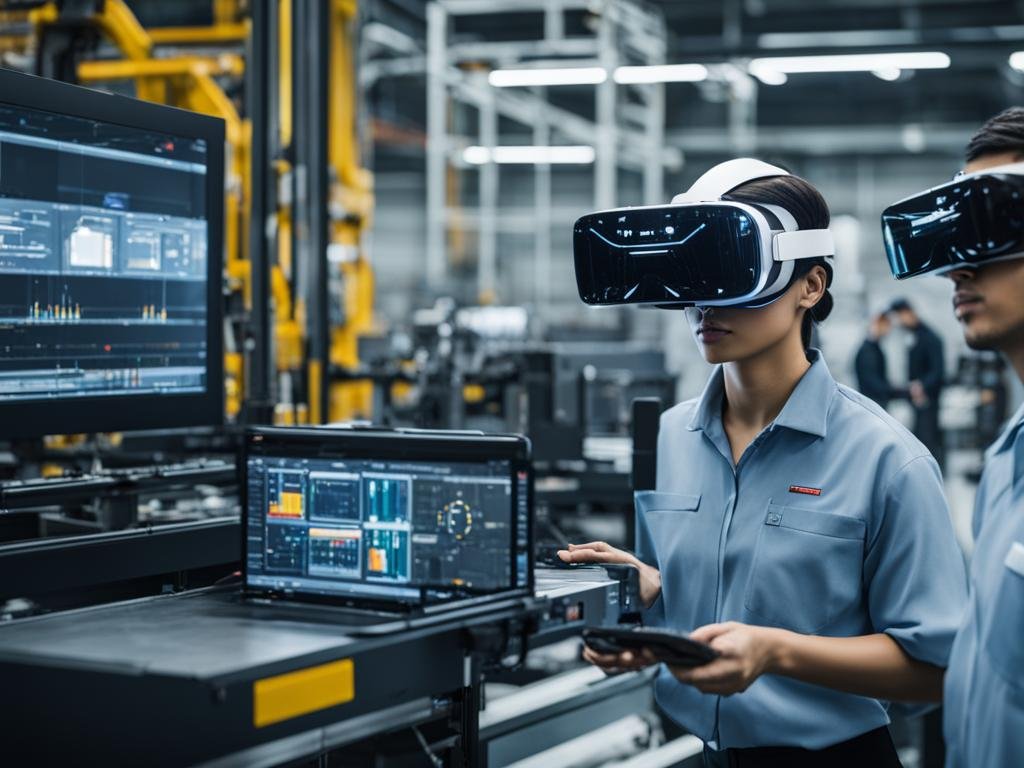
The Benefits of AR and VR in Manufacturing:
- Enhanced training programs through realistic simulations
- Streamlined maintenance tasks with real-time visualizations and instructions
- Improved design and visualization of products and manufacturing processes
- Effective simulations for analyzing scenarios and optimizing production
AR and VR have the potential to transform manufacturing by providing immersive and interactive experiences that improve productivity, efficiency, and decision-making. As these technologies continue to evolve and become more accessible, their adoption in the manufacturing industry is expected to grow, unlocking new possibilities and driving innovation.
Industry 4.0 and the Future of Manufacturing
Industry 4.0, also known as the Fourth Industrial Revolution, is revolutionizing the manufacturing sector. It encompasses the integration of smart factories, Internet of Things (IoT), automation, data analytics, predictive maintenance, and real-time monitoring. This convergence of technologies is reshaping the manufacturing landscape and driving unprecedented levels of efficiency, productivity, and innovation.
Smart factories are at the heart of Industry 4.0, enabling seamless connectivity and communication between machines, systems, and humans. Through IoT, machines collect real-time data, providing valuable insights into production processes. This data is then analyzed using advanced analytics and artificial intelligence algorithms to optimize operations, improve quality control, and enable predictive maintenance.
In addition to data analytics, automation plays a significant role in Industry 4.0. By automating repetitive tasks, manufacturers can enhance productivity, reduce errors, and improve overall efficiency. Robots and cobots work alongside humans, creating a harmonious collaboration that combines human creativity and problem-solving skills with the precision and speed of machines.
The Benefits of Industry 4.0 in Manufacturing
- Increased efficiency: With real-time data and advanced analytics, manufacturers can identify bottlenecks and optimize production processes, reducing waste and improving overall efficiency.
- Cost savings: Automation and predictive maintenance help minimize downtime, reduce energy consumption, and lower operational costs, leading to significant savings for manufacturers.
- Improved quality control: Real-time monitoring and data analytics enable manufacturers to detect defects or anomalies in the production process, ensuring the highest quality standards are met.
- Enhanced flexibility: Industry 4.0 technologies allow for agile production processes, enabling manufacturers to quickly respond to changing customer demands and market trends.
As the manufacturing industry continues to embrace Industry 4.0, it is poised to experience unprecedented growth and transformation. The future of manufacturing lies in the seamless integration of technologies, data-driven decision-making, and the ability to adapt quickly to changing market dynamics. Companies that embrace Industry 4.0 will gain a competitive advantage and be well-positioned for success in the evolving landscape of manufacturing.
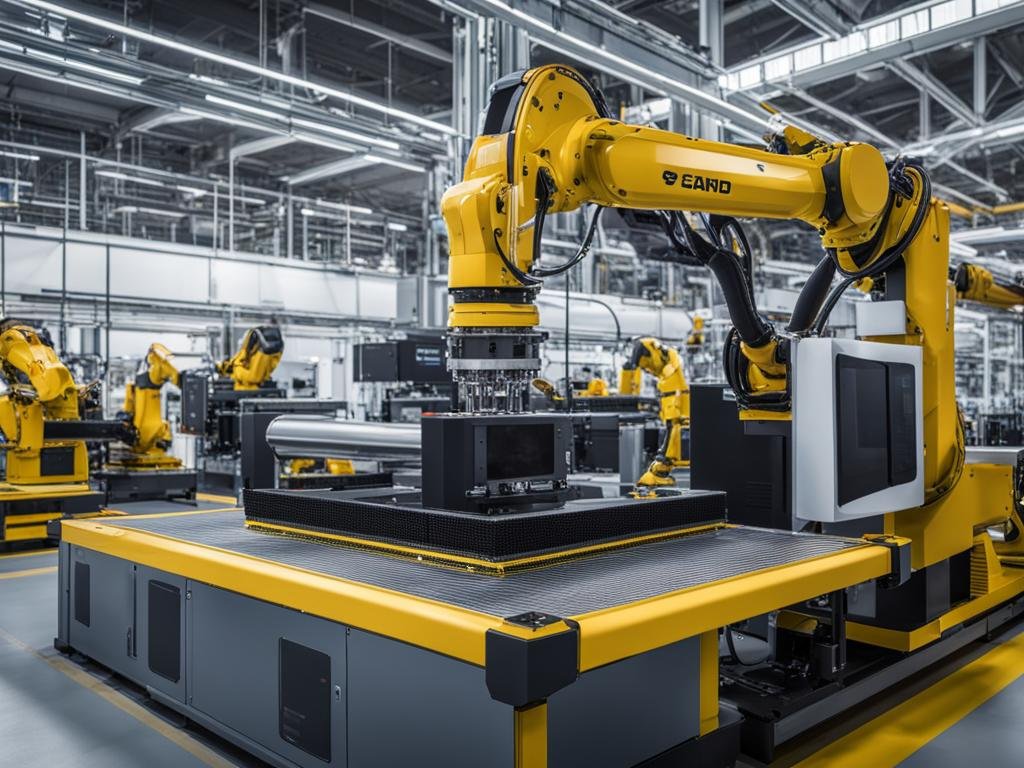
Also Read : Explore Your Future At International Technological University
Conclusion
The future of manufacturing is poised for tremendous growth and transformation, driven by technological advances and constant innovation. With the rapid evolution of manufacturing technology and the increasing adoption of digital solutions, companies have the opportunity to revolutionize their operations, optimize their business models, and stay ahead of the competition.
By embracing technology in manufacturing, companies can unlock new possibilities for efficiency, productivity, and sustainability. From advanced robotics and artificial intelligence to augmented and virtual reality, these technological advancements enable manufacturers to automate processes, enhance product quality, and improve overall performance.
Furthermore, technology in manufacturing paves the way for business model transformation. Companies can leverage digital tools and insights to create new value for customers, streamline operations, and explore innovative revenue streams. Embracing a customer-centric approach and adapting to changing market demands will be crucial for success in the future of manufacturing.
In conclusion, the future of manufacturing is filled with exciting potential. Through continuous investment in technology, innovation, and business model transformation, manufacturers can thrive in a rapidly evolving landscape. By staying agile, embracing change, and leveraging the latest advancements, the manufacturing industry is well-positioned to shape the future and drive progress in the global economy.
FAQs
Q: What is the future of manufacturing technology?
A: The future of manufacturing technology encompasses a broad range of advancements, including 3d printing, artificial intelligence, internet of things, cloud computing, automation, and robotics. These technologies are transforming the manufacturing industry by increasing productivity, reducing production time, and lowering labor costs.
Q: How does 3D printing impact manufacturing?
A: 3D printing, also known as additive manufacturing, has revolutionized the way manufacturers produce components. It allows them to produce complex and intricate designs, thereby reducing production time and costs across the manufacturing process.
Q: What is the role of artificial intelligence in manufacturing?
A: Artificial intelligence (AI) is used to develop machine learning and predictive analytics in manufacturing. This technology also helps in predictive maintenance, reliability, and industrial internet of things (IIoT) by integrating big data analytics to predict machine failures and reduce downtime.
Q: How does the Internet of Things (IoT) contribute to the manufacturing industry?
A: The Internet of Things (IoT) allows manufacturers to collect and analyze production data in real-time, enabling them to optimize processes, improve quality control, and reduce waste. It also helps in reshoring by bringing back production to their home countries.
Q: What are the benefits of using cloud computing in manufacturing?
A: Cloud computing offers manufacturers the advantage of scalability, cost-effectiveness, and secure data storage. It allows seamless access to data across multiple locations and real-time collaboration, facilitating efficient decision-making and innovation across the supply chain.
Q: How does automation impact the manufacturing sector?
A: Automation across the manufacturing process streamlines operations, reduces errors, and increases overall productivity. It also helps in the adoption of future factories with computer vision in warehouses, robotic integration, and machine learning to integrate tasks seamlessly.
Q: What is the significance of reliability in manufacturing technologies?
A: Reliability plays a crucial role in manufacturing technologies, ensuring consistent and high-quality production. It helps in the reduction of waste, improves efficiency, and fosters customer trust in the products being manufactured.
Q: How do wearable technologies influence the manufacturing environment?
A: Wearable technologies enhance safety, efficiency, and real-time data access in manufacturing environments. They provide workers with instant information, help in monitoring their health and performance, and contribute to improved productivity and safety protocols.
Q: What is the impact of industrial internet of things (IIoT) in manufacturing?
A: The industrial internet of things (IIoT) revolutionizes manufacturing by enabling machines to communicate and operate autonomously. It enables predictive maintenance, increased operational efficiency, and facilitates the adoption of advanced technologies like robotics and automation.
Q: How does ERP software aid in manufacturing processes?
A: Enterprise Resource Planning (ERP) software integrates various aspects of manufacturing, including planning, inventory, supply chain, and customer management. It ensures efficient resource allocation, streamlined production, and improved decision-making for manufacturing companies.
Source Links
- https://www3.weforum.org/docs/WEF_Unlocking_Business_Model_Innovation_through_Advanced_Manufacturing_2022.pdf
- https://www.mckinsey.com/industries/automotive-and-assembly/our-insights/the-future-is-now-unlocking-the-promise-of-ai-in-industrials
- https://www.forbes.com/sites/iese/2021/06/04/how-managers-can-unlock-the-potential-of-new-technologies/?sh=2660188f2d55

